标签:style blog http io ar 使用 sp java on
楼主做前端开发一年多了,对前端的见解还是多多少少有一点的,今天特拿出来跟大家分享分享。
做前端开发少不了各种利器。比如我习惯用的还是Google浏览器和重型武器Fiddller。
一: 原始情况
首先大家看看如下的代码:
1 <%@ Page Language="C#" AutoEventWireup="true" CodeBehind="Default.aspx.cs" Inherits="JsLoad.Default" %> 2 3 <!DOCTYPE html PUBLIC "-//W3C//DTD XHTML 1.0 Transitional//EN" "http://www.w3.org/TR/xhtml1/DTD/xhtml1-transitional.dtd"> 4 <html xmlns="http://www.w3.org/1999/xhtml"> 5 <head id="head"> 6 <title></title> 7 <link href="Styles/Site.css" rel="stylesheet" type="text/css" /> 8 <script src="jquery/jquery-1.4.1.js" type="text/javascript"></script> 9 <script src="js/hello.js" type="text/javascript"></script> 10 <script src="js/world.js" type="text/javascript"></script> 11 </head> 12 <body> 13 <img src="1.jpg" width="200" height="300" /> 14 </body> 15 </html>
估计90%的程序员都会把js文件放在head中,但是大家有没有深究过呢?很多浏览器都会使用单一的线程来做“界面UI的更新”和“JS脚本的处理“,
也就是当执行引擎遇到”<script>“的时候,此时页面的下载和渲染都必须等待<script>执行完毕。那么对用户而言就悲哀了,看着锁住的页面,
此时用户很可能就会给你关掉。
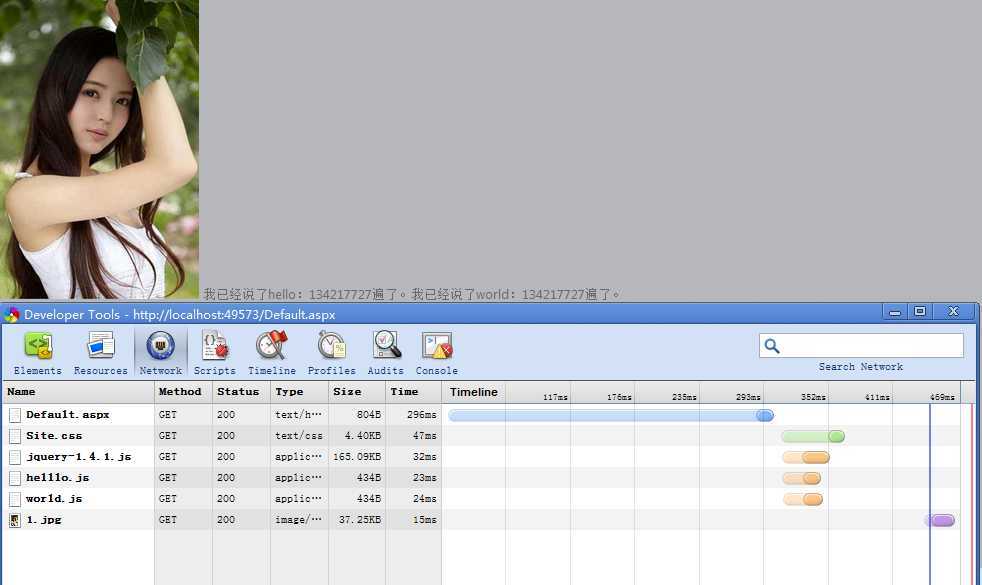
从上面的瀑布图中我们可以看出二点:
第一:
三个js文件并行下载,但是按我上面的理论中js应该是一个接一个的执行。然而在IE8,Firefox3.5和Chrome2都实现了js的并行下载,
这是相当不错的,但是他还是会阻碍一些其他资源的下载,比如说图片。
第二:
图片1.jpg的下载是在js执行完成后触发的,这也验证了上面所说的情况,阻止了image的加载。
二:第一步优化
既然js阻止了UI渲染,那么我们可以考虑将js放在</body>前,这样就可以让<script>前的html完美的呈现,不会让用户看到页面空白等待
而苦恼的情况,自然就提高了友好性。
1 <%@ Page Language="C#" AutoEventWireup="true" CodeBehind="Default.aspx.cs" Inherits="JsLoad.Default" %> 2 3 <!DOCTYPE html PUBLIC "-//W3C//DTD XHTML 1.0 Transitional//EN" "http://www.w3.org/TR/xhtml1/DTD/xhtml1-transitional.dtd"> 4 <html xmlns="http://www.w3.org/1999/xhtml"> 5 <head id="head"> 6 <title></title> 7 <link href="Styles/Site.css" rel="stylesheet" type="text/css" /> 8 </head> 9 <body> 10 <img src="1.jpg" width="200" height="300" /> 11 <script src="jquery/jquery-1.4.1.js" type="text/javascript"></script> 12 <script src="js/hello.js" type="text/javascript"></script> 13 <script src="js/world.js" type="text/javascript"></script> 14 </body> 15 </html>
下面的图也展示了1.jpg和三个js几乎并行下载和执行。时间由上面的“469ms+”缩小到“326ms”。
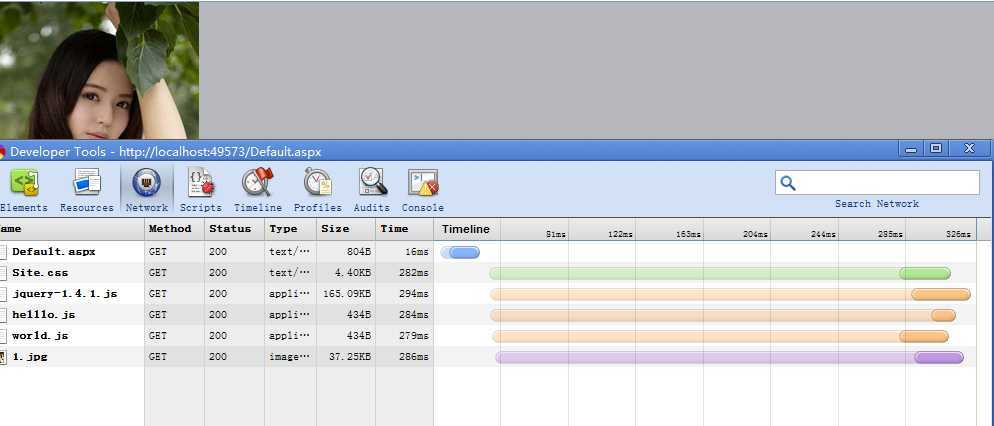
三:第二步优化
看上面的“瀑布图”,估计大家也看出来了,三个js文件进行了三次“Get”请求,大家都知道Get请求是需要带http头的,
所以说需要耗费时间,那么我们采取的方案自然就是减少Get请求。通常有两种方案。
第一:合并js文件,比如将上面的“hello.js"和“world.js“合并掉。
第二:利用第三方工具,比如php中的Minify。
关于第二种做法,taobao用的还是比较多的,看一下其中的一个script,应用了三个js文件。由3个Get请求变为了1个。
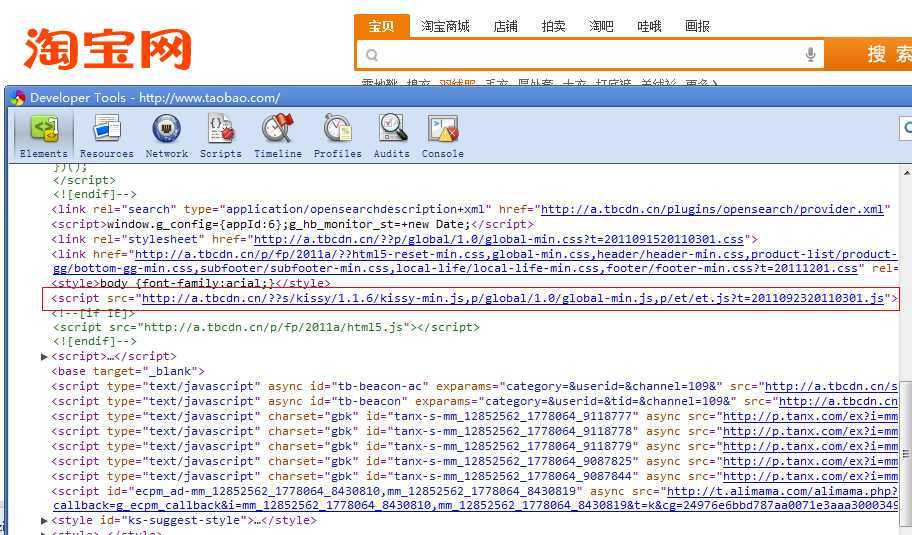
四:第三步优化
不管是把js文件放在脚尾,还是三个合并一个,其本质都是”阻塞模式“,就是说锁死浏览器,当web页面越来越复杂,js文件越来越多,还是
让我们头疼的,此时我们就提倡一种“无阻塞模式“加载js脚本,也就是页面全部呈现完再追加js,也就对应着window.onload事件触发后,我们才
追加js,这就是所谓的“无阻塞“,但是其中有一个非常要注意的地方就是我们对js的要求是否有严格的顺序。
第一:无顺序要求,比如我对”hello.js“和”world.js"没有顺序要求,那么我们完全可以用jquery来动态追加实现。
1 <%@ Page Language="C#" AutoEventWireup="true" CodeBehind="Default.aspx.cs" Inherits="JsLoad.Default" %>
2
3 <!DOCTYPE html PUBLIC "-//W3C//DTD XHTML 1.0 Transitional//EN" "http://www.w3.org/TR/xhtml1/DTD/xhtml1-transitional.dtd">
4 <html xmlns="http://www.w3.org/1999/xhtml">
5 <head id="head">
6 <title></title>
7 <link href="Styles/Site.css" rel="stylesheet" type="text/css" />
8 </head>
9 <body>
10 <img src="1.jpg" width="200" height="300" />
11 <script src="jquery/jquery-1.4.1.js" type="text/javascript"></script>
12 <script type="text/javascript">
13 window.onload = function () {
14 $("#head").append("<script src=‘js/hello.js‘ type=‘text/javascript‘><\/script>")
15 $("#head").append("<script src=‘js/world.js‘ type=‘text/javascript‘><\/script>");
16 }
17 </script>
18 </body>
19 </html>
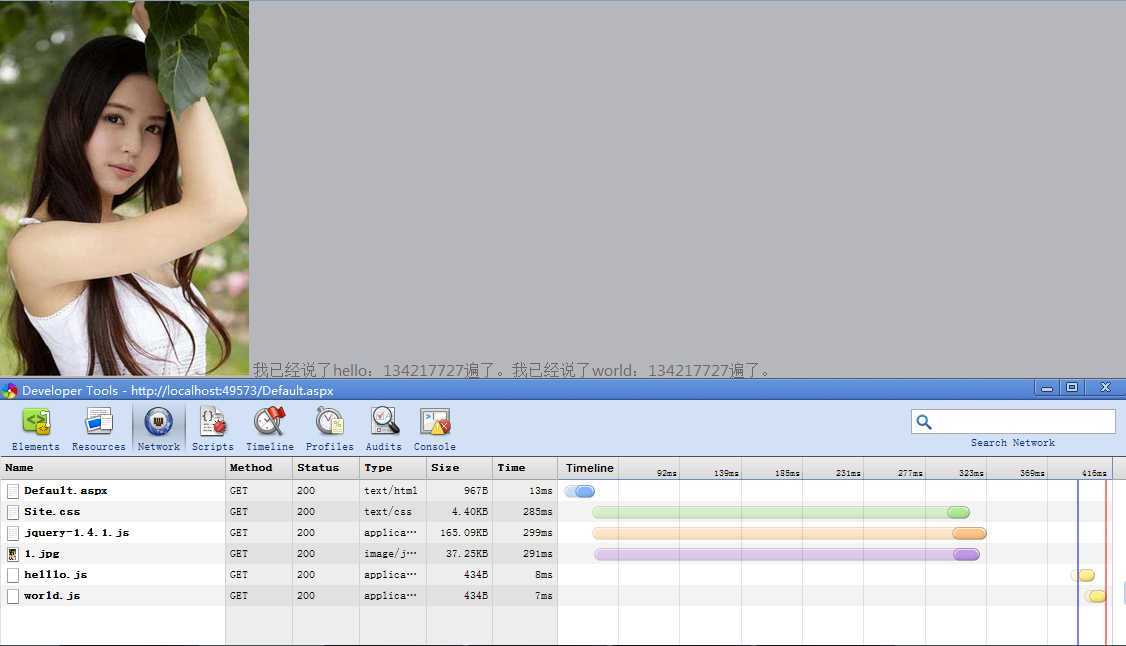
从图中可以看出,"hello.js"和“world.js"出现在蓝色线以后,也就说明这两个js是在DomContentLoad结束后再进行触发加载的,这样就不会造成页面的锁定
等待。
第二:有顺序要求
为什么一定要有顺序要求这个概念呢?对于上面的那个动态追加的“两个js”文件,在IE系列中,你不能保证hello.js一定会在world.js前执行,
他只会按照服务器端返回的顺序执行代码。
1 <%@ Page Language="C#" AutoEventWireup="true" CodeBehind="Default.aspx.cs" Inherits="JsLoad.Default" %>
2
3 <!DOCTYPE html PUBLIC "-//W3C//DTD XHTML 1.0 Transitional//EN" "http://www.w3.org/TR/xhtml1/DTD/xhtml1-transitional.dtd">
4 <html xmlns="http://www.w3.org/1999/xhtml">
5 <head id="head">
6 <title></title>
7 <link href="Styles/Site.css" rel="stylesheet" type="text/css" />
8 </head>
9 <body>
10 <img src="1.jpg" width="200" height="300" />
11 <script type="text/javascript">
12 function loadScript(url, callback) {
13 var script = document.createElement("script");
14 script.type = "text/javascript";
15
16 //IE
17 if (script.readyState) {
18 script.onreadystatechange = function () {
19 if (script.readyState == "loaded" || script.readyState == "complete") {
20 script.onreadystatechange = null;
21 callback();
22 }
23 }
24 } else {
25 //非IE
26 script.onload = function () {
27 callback();
28 }
29 }
30 script.src = url;
31 document.getElementById("head").appendChild(script);
32 }
33 //第一步加载jquery类库
34 loadScript("jquery/jquery-1.4.1.js", function () {
35 //第二步加载hello.js
36 loadScript("js/hello.js", function () {
37 //第三步加载world.js
38 loadScript("js/world.js", function () {
39
40 });
41 });
42 });
43 </script>
44 </body>
45 </html>

大家也能看到,页面完全Load的时间其实也就310ms左右,大大提高了网页的下载呈现和友好型。
同样也可以看看腾讯网,他也是这么干的。
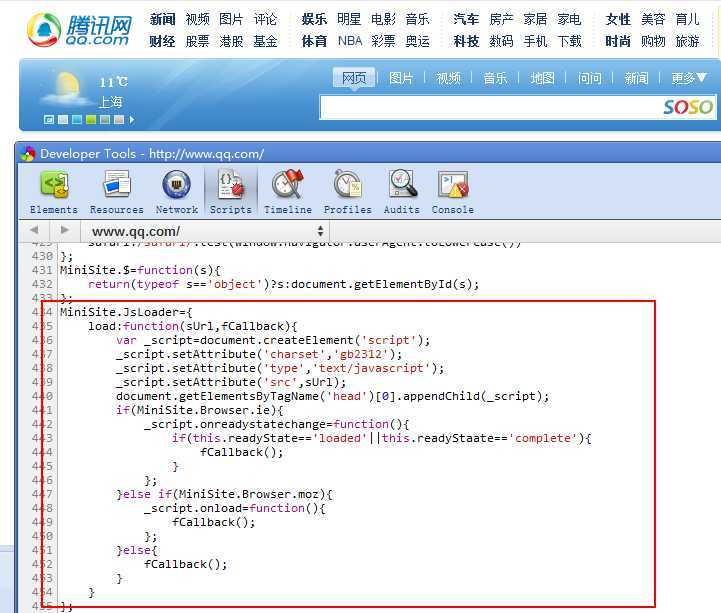
标签:style blog http io ar 使用 sp java on
原文地址:http://www.cnblogs.com/ranzige/p/4165189.html